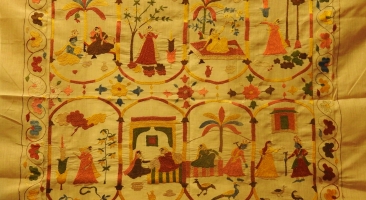Chamba rumal, as Chamba embroidery is popularly called, is brought to life by an arduous process where miniature painting meets weaving, opening up a world of stories carried through generations and traditions that speak of nature, faith and life, thus forming not just an embroidered masterpiece but a piece of literature itself. Usually embroidered on khaddar or muslin, its repertoire includes the daily life of Chamba, folk stories of the region as well as prominent stories from religious myths.
Chamba rumal originated in the Chamba region of Himachal Pradesh, and was widely practised until the nineteenth century. It can be broadly categorised into the folk style of embroidery present in Chamba and several other states of northern India in various forms like coverings, patwars (belts), cholis (blouses), caps, scarves, pillow covers, household accessories, chaupar (a game of dice) cloths, bedstead, wall hangings, chandwas (ceiling covers), and pankhas (fans) and the miniature style rumals that came to be in the late sixteenth to seventeenth centuries.
In the early twentieth century, the art of Chamba rumal suffered a great deal due to lack of patronage and almost died out before it was revived post-Independence by the efforts of Kamaladevi Chattopadhyay and, later, Delhi Crafts Council.
